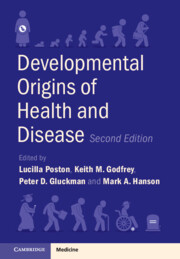121 results
Section IV - Mechanisms
-
- Book:
- Developmental Origins of Health and Disease
- Published online:
- 01 December 2022
- Print publication:
- 22 December 2022, pp 132-175
-
- Chapter
- Export citation
Chapter 20 - DOHaD: Engaging with New Global Issues to Inform Policy
- from Section VI - Public Health and Policy Implications of Interventions
-
-
- Book:
- Developmental Origins of Health and Disease
- Published online:
- 01 December 2022
- Print publication:
- 22 December 2022, pp 213-220
-
- Chapter
- Export citation
Chapter 2 - The Evolutionary Basis of DOHaD
- from Section II - Exposures Driving Long-Term DOHaD Effects
-
-
- Book:
- Developmental Origins of Health and Disease
- Published online:
- 01 December 2022
- Print publication:
- 22 December 2022, pp 7-15
-
- Chapter
- Export citation
Contributors
-
- Book:
- Developmental Origins of Health and Disease
- Published online:
- 01 December 2022
- Print publication:
- 22 December 2022, pp vii-x
-
- Chapter
- Export citation
Chapter 1 - Overview and Introduction to the Second Edition of Developmental Origins of Health and Disease
- from Section I - Overview
-
-
- Book:
- Developmental Origins of Health and Disease
- Published online:
- 01 December 2022
- Print publication:
- 22 December 2022, pp 1-6
-
- Chapter
- Export citation
Section II - Exposures Driving Long-Term DOHaD Effects
-
- Book:
- Developmental Origins of Health and Disease
- Published online:
- 01 December 2022
- Print publication:
- 22 December 2022, pp 7-84
-
- Chapter
- Export citation
Preface
-
- Book:
- Developmental Origins of Health and Disease
- Published online:
- 01 December 2022
- Print publication:
- 22 December 2022, pp xi-xii
-
- Chapter
- Export citation
Copyright page
-
- Book:
- Developmental Origins of Health and Disease
- Published online:
- 01 December 2022
- Print publication:
- 22 December 2022, pp iv-iv
-
- Chapter
- Export citation
Index
-
- Book:
- Developmental Origins of Health and Disease
- Published online:
- 01 December 2022
- Print publication:
- 22 December 2022, pp 221-226
-
- Chapter
- Export citation
Section I - Overview
-
- Book:
- Developmental Origins of Health and Disease
- Published online:
- 01 December 2022
- Print publication:
- 22 December 2022, pp 1-6
-
- Chapter
- Export citation
Section VI - Public Health and Policy Implications of Interventions
-
- Book:
- Developmental Origins of Health and Disease
- Published online:
- 01 December 2022
- Print publication:
- 22 December 2022, pp 203-220
-
- Chapter
- Export citation
Section III - Outcomes
-
- Book:
- Developmental Origins of Health and Disease
- Published online:
- 01 December 2022
- Print publication:
- 22 December 2022, pp 85-131
-
- Chapter
- Export citation
Contents
-
- Book:
- Developmental Origins of Health and Disease
- Published online:
- 01 December 2022
- Print publication:
- 22 December 2022, pp v-vi
-
- Chapter
- Export citation
Section V - Interventions
-
- Book:
- Developmental Origins of Health and Disease
- Published online:
- 01 December 2022
- Print publication:
- 22 December 2022, pp 176-202
-
- Chapter
- Export citation
Barriers to and solutions for representative inclusion across the lifespan and in life course research: The need for structural competency highlighted by the COVID-19 pandemic
-
- Journal:
- Journal of Clinical and Translational Science / Volume 7 / Issue 1 / 2023
- Published online by Cambridge University Press:
- 06 December 2022, e38
-
- Article
-
- You have access
- Open access
- HTML
- Export citation

Developmental Origins of Health and Disease
-
- Published online:
- 01 December 2022
- Print publication:
- 22 December 2022
Further Reading
-
- Book:
- What Makes a Person?
- Published online:
- 03 November 2022
- Print publication:
- 03 November 2022, pp 174-174
-
- Chapter
- Export citation
Acknowledgements
-
- Book:
- What Makes a Person?
- Published online:
- 03 November 2022
- Print publication:
- 03 November 2022, pp 172-173
-
- Chapter
- Export citation
Copyright page
-
- Book:
- What Makes a Person?
- Published online:
- 03 November 2022
- Print publication:
- 03 November 2022, pp vi-vi
-
- Chapter
- Export citation
6 - The Gift
-
- Book:
- What Makes a Person?
- Published online:
- 03 November 2022
- Print publication:
- 03 November 2022, pp 149-171
-
- Chapter
- Export citation



